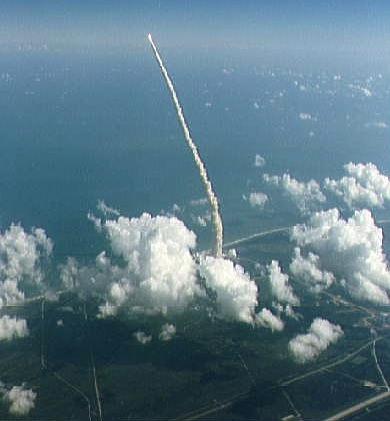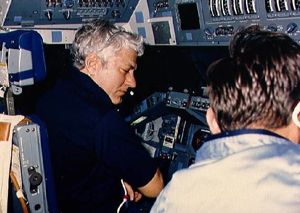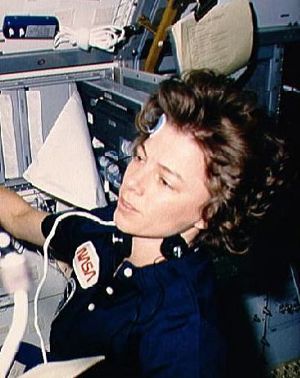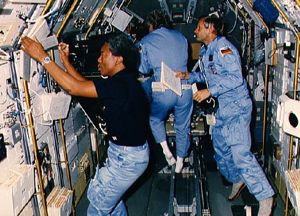
Home - Search - Browse - Alphabetic Index: 0- 1- 2- 3- 4- 5- 6- 7- 8- 9
A- B- C- D- E- F- G- H- I- J- K- L- M- N- O- P- Q- R- S- T- U- V- W- X- Y- Z
STS-61-A

STS-61-A
Launch of the shuttle Challenger and beginning of STS 61-A mission
Credit: NASA
AKA: Challenger;Spacelab D1. Launched: 1985-10-30. Returned: 1985-11-06. Number crew: 8 . Duration: 7.03 days.
Payloads: Spacelab D-1 with habitable module and 76 experiments. Six of the eight crew members were divided into a blue and red team working 12-hour shifts for 24-hour-a-day operation. The remaining two crew members were 'switch hitters.'.
Orbits of Earth: 111. Distance traveled: 4,682,148 km. Orbiter Liftoff Mass: 110,568 kg. Orbiter Mass at Landing: 97,144 kg. Payload to Orbit: 14,451 kg. Payload Returned: 14,383 kg. Landed at: Runway 17 dry lake bed at Edwards Air Force Base, . Landing Speed: 376 kph. Touchdown miss distance: 557 m. Landing Rollout: 2,531 m.
NASA Official Mission Narrative
Mission Name: 61-A (22)
CHALLENGER (9)
Pad 39-A (34)
22nd Shuttle mission
9th Flight OV-099
Crew:
Henry W. Hartsfield, Jr.(3), Commander
Steven R. Nagel (3), Pilot
James F. Buchli (2), Mission Specialist 1
Guion S. Bluford, Jr.(2), Mission Specialist 2
Bonnie J. Dunbar (1), Mission Specialist 3
Reinhard Furrer (1), Payload Specialist 1
Ernst Messerschmid (1), Payload Specialist 2
Wubbo J. Ockeis (1), Payload Specialist (ESA) 3
Milestones:
OPF - Aug. 12,1985
VAB - Oct. 12,1985
PAD - Oct. 16,1985
Payload:
SPACELAB-D1,GLOMAR
Mission Objectives:
Launch:
October 30, 1985, 12:00:00 noon EST. Launch proceeded as scheduled with no delays. Launch Weight: 243,762 lbs.
Orbit:
Altitude: 207nm
Inclination: 57.0 degrees
Orbits: 112
Duration: 7 days, 0 hours, 44 minutes, 51 seconds.
Distance: miles
Hardware:
SRB: BI-022
SRM: L022(HPM)
ET : 24/LWT-17
MLP : 1
SSME-1: SN-2023
SSME-2: SN-2020
SSME-3: SN-2021
Landing:
November 6,1985,9:44:51 a.m. PST, Runway 17, Edwards Air Force Base. Calif. Rollout distance: 8,304 feet. Rollout time: 49 seconds. Mission duration: Orbiter returned to KSC Nov. 11, 1985. Landing Weight: 214,171 lbs.
Mission Highlights:
Dedicated German Spacelab (D-1) mission conducted in long module configuration, which featured Vestibular Sled designed to give scientists data on functional organization of human vestibular and orientation systems. Spacelab D-1 encompassed 75 numbered experiments, most performed more than once. Mission included basic and applied microgravity research in fields of materials science, life sciences and technology, and communications and navigation. Though orbiter controlled from Johnson Space Center, scientific operations controlled from German Space Operations Center at Oberpfaffenhofen, near Munich. Other objectives: Global Low Orbiting Message Relay (GLOMR) satellite deployed from Get Away Special canister.
More at: STS-61-A.
Family: Manned spaceflight. People: Bluford, Buchli, Dunbar, Furrer, Hartsfield, Messerschmid, Nagel, Ockels. Country: USA. Spacecraft: Challenger. Projects: STS. Launch Sites: Cape Canaveral. Agency: NASA, NASA Houston.
 | STS-61-A STS 61-A crewmembers in Spacelab D-1 science module Credit: NASA |
 | STS-61-A Astronauts Hartsfield and Nagel on the forward flight deck Credit: NASA |
 | STS-61-A Astronaut Bonnie Dunbar preparing to perform bio-medical test Credit: NASA |
 | STS-61-A STS 61-A crewmembers in Spacelab D-1 science module Credit: NASA |
1985 October 30 - . 17:00 GMT - . Launch Site: Cape Canaveral. Launch Complex: Cape Canaveral LC39A. Launch Platform: MLP1. LV Family: Shuttle. Launch Vehicle: Space Shuttle.
- STS-61-A - .
Call Sign: Challenger. Crew: Bluford,
Buchli,
Dunbar,
Furrer,
Hartsfield,
Messerschmid,
Nagel,
Ockels.
Payload: Challenger F09 / GLOMR 1. Mass: 14,451 kg (31,859 lb). Nation: USA.
Related Persons: Bluford,
Buchli,
Dunbar,
Furrer,
Hartsfield,
Messerschmid,
Nagel,
Ockels.
Agency: NASA Houston.
Program: STS.
Class: Manned.
Type: Manned spaceplane. Flight: STS-61-A.
Spacecraft Bus: Shuttle.
Spacecraft: Challenger.
Duration: 7.03 days. Decay Date: 1985-11-06 . USAF Sat Cat: 16230 . COSPAR: 1985-104A. Apogee: 331 km (205 mi). Perigee: 319 km (198 mi). Inclination: 57.00 deg. Period: 91.00 min.
Manned eight crew. Launched GLOMR; carried Spacelab D1. Payloads: Spacelab D-1 with habitable module and 76 experiments. Six of the eight crew members were divided into a blue and red team working 12-hour shifts for 24-hour-a-day operation. The remaining two crew members were 'switch hitters.'.
1985 November 6 - .
- Landing of STS-61-A - . Return Crew: Bluford, Buchli, Dunbar, Furrer, Hartsfield, Messerschmid, Nagel, Ockels. Nation: USA. Related Persons: Bluford, Buchli, Dunbar, Furrer, Hartsfield, Messerschmid, Nagel, Ockels. Program: Spacelab. Flight: STS-61-A. STS-61-A landed at 18:01 GMT. .
Back to top of page
Home - Search - Browse - Alphabetic Index: 0- 1- 2- 3- 4- 5- 6- 7- 8- 9
A- B- C- D- E- F- G- H- I- J- K- L- M- N- O- P- Q- R- S- T- U- V- W- X- Y- Z
© 1997-2019 Mark Wade - Contact
© / Conditions for Use